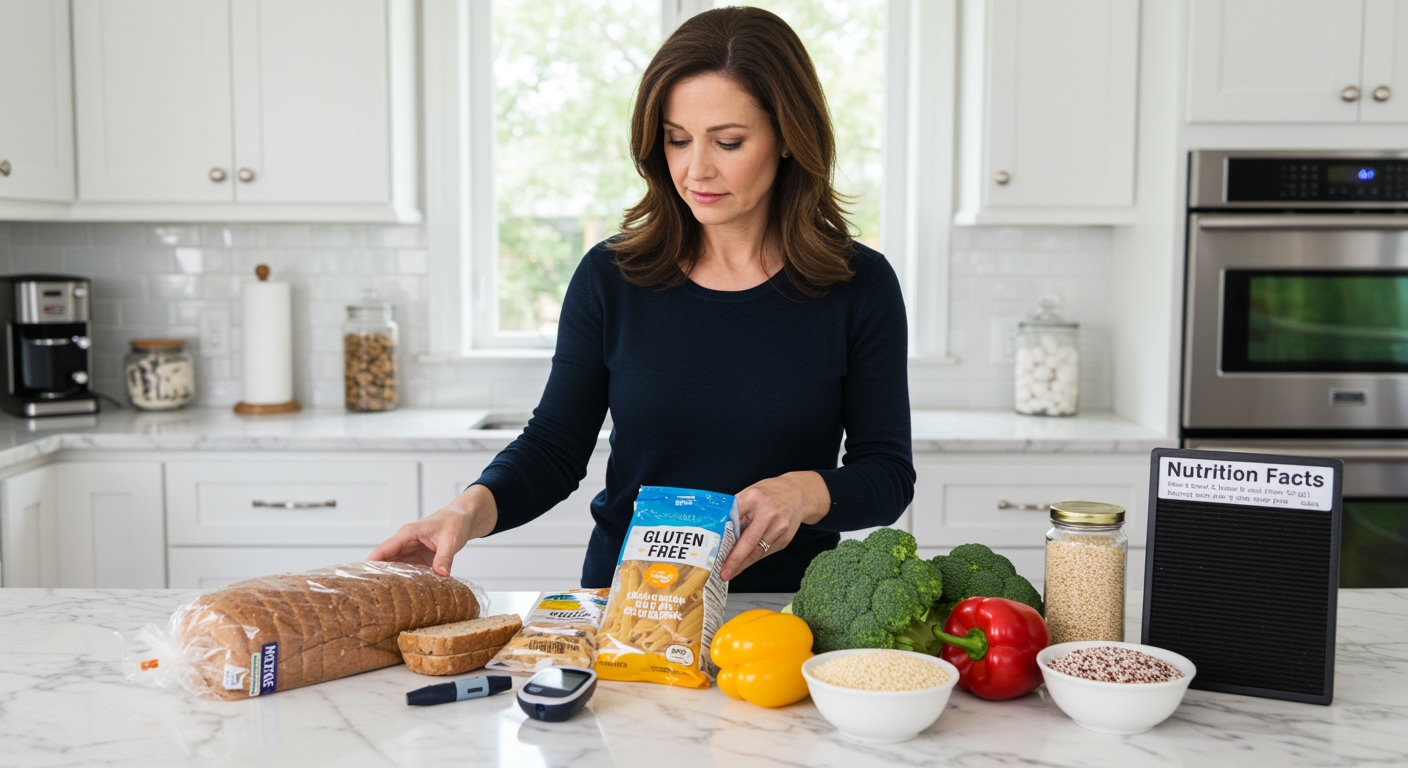✪ Key Takeaway: Gluten-free foods are not automatically better for diabetes and may contain more sugar and refined starches than regular foods.
Introduction
Walk down any grocery aisle today and you will see gluten-free labels everywhere.
Many people with diabetes wonder if switching to gluten-free foods will help them manage their blood sugar better.
Hi, I am Abdur, your nutrition coach and today I am going to explain whether gluten-free foods are actually good for diabetes management.
What Exactly Is Gluten And Why Do People Avoid It?
Gluten is a protein found in wheat, barley, rye, and other grains.
This protein gives bread its chewy texture and helps dough rise properly.
People with celiac disease must avoid gluten completely because their immune system attacks their small intestine when they eat it.
Others avoid gluten because they believe it causes inflammation or digestive problems.
The gluten-free market has exploded because many people think these foods are automatically healthier than regular foods.
However, this belief is not always true, especially for people managing diabetes.
✪ Fact: Only 1% of the population has celiac disease, but the gluten-free market serves millions of consumers.
Do Gluten-Free Foods Actually Help Control Blood Sugar?
Most gluten-free processed foods contain refined starches like rice flour, potato starch, and corn starch.
These ingredients can cause blood sugar spikes just as quickly as regular wheat flour.
Research shows that gluten-free bread often has a higher glycemic index than whole wheat bread.
This means gluten-free bread can raise your blood glucose levels faster and higher than regular bread.
Many gluten-free products also contain added sugars to improve taste and texture.
Food manufacturers add these sugars because gluten-free products often taste bland without them.
The fiber content in gluten-free products is usually lower than their wheat-based counterparts.
✪ Pro Tip: Always check the total carbohydrate content on nutrition labels rather than focusing only on the gluten-free claim.
What Are The Hidden Dangers Of Gluten-Free Processed Foods?
Gluten-free processed foods often contain more calories per serving than regular versions.
This happens because manufacturers add extra fats and sugars to make up for the missing gluten.
The sodium content in gluten-free products is frequently higher than in regular foods.
High sodium intake can worsen blood pressure problems, which are common in people with diabetes.
Many gluten-free products lack important B vitamins and iron that are naturally found in fortified wheat products.
This nutritional gap can lead to deficiencies if you rely heavily on gluten-free processed foods.
The cost of gluten-free products is typically 2-3 times higher than regular alternatives.
✪ Note: Gluten-free does not mean low-carb, sugar-free, or automatically healthier for diabetes management.
When Might Gluten-Free Foods Actually Benefit People With Diabetes?
People with both diabetes and celiac disease must follow a gluten-free diet for their health.
Research shows that about 6% of people with type 1 diabetes also have celiac disease.
For these individuals, eating gluten causes intestinal damage that can affect nutrient absorption and blood sugar control.
Some people with diabetes report better digestion when they avoid gluten-containing processed foods.
However, this improvement might come from eating fewer processed foods overall rather than avoiding gluten specifically.
Naturally gluten-free whole foods like quinoa, sweet potatoes, and brown rice can be excellent choices for diabetes management.
These foods provide fiber, nutrients, and steady energy without the need for processed gluten-free alternatives.
✪ Pro Tip: Focus on naturally gluten-free whole foods rather than processed gluten-free substitutes for better blood sugar control.
What Should You Choose Instead For Better Diabetes Management?
The best approach for diabetes management focuses on whole foods regardless of their gluten content.
Choose foods that are naturally low in refined carbohydrates and high in fiber.
Vegetables, lean proteins, healthy fats, and moderate amounts of complex carbohydrates should form the foundation of your diet.
If you want bread or pasta, look for whole grain versions with at least 3 grams of fiber per serving.
These options will have less impact on your blood sugar than most gluten-free processed alternatives.
When you do choose gluten-free products, read labels carefully and compare the total carbohydrate content with regular versions.
Remember that portion control and timing matter more than whether your food contains gluten or not.
✪ Fact: A small portion of whole wheat pasta may affect blood sugar less than a large portion of gluten-free pasta.
The Bottom Line
Gluten-free foods are not automatically better for diabetes management and may actually contain more sugar and refined starches than regular alternatives.
Smart food choices focus on nutrients and blood sugar impact, not marketing labels.
I would love to hear about your experiences with gluten-free foods and diabetes management in the comments below.
References
At NutritionCrown, we use quality and credible sources to ensure our content is accurate and trustworthy. Below are the sources referenced in creating this article:
- PMC: Gluten-Free Diet and Cardiovascular Risk Factors in Patients with Coeliac Disease
- Virta Health: Gluten-Free and Diabetes
- Medical News Today: Gluten-Free Diet and Diabetes
- American Diabetes Association: Gluten-Free Diet





